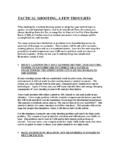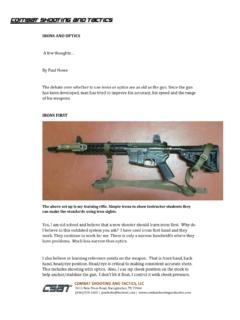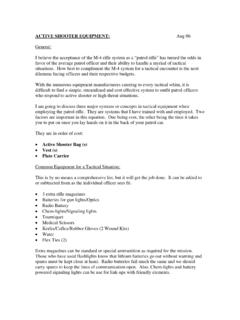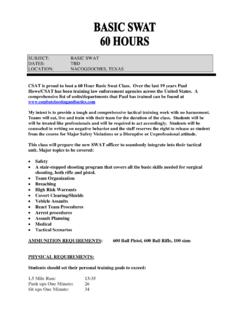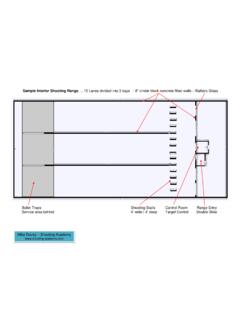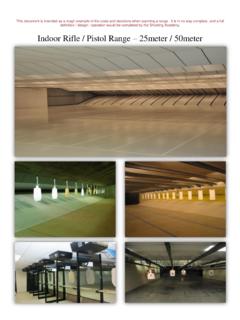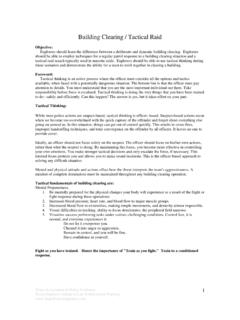Transcription of Training For The Fight 05 - Combat Shooting and …
1 Training FOR THE REAL Fight OR AVOIDING FANSTASY GUNFIGHT Training Realistic Training for a future gunfight is critical for a successful outcome. My Combat experiences have taught me to reevaluate my Training system, work ethic and how to channelize my Training regime into a more streamlined and effective package. It also confirmed some lessons while voiding others. Proven Combat techniques may not be flashy and may require a bit more physical effort on the part of the shooter. Further, they may not win competition matches, but they will help ensure your survival in a Shooting or gunfight on the street.
2 First, I learned through experience that I would rather be in a Shooting than a Gunfight. The difference is simple. A Shooting is one-way event, all the Shooting is done by me. The gunfight is where your opponent has the opportunity to Fight back. I prefer the Shooting to the gun Fight as getting shot at leads to getting shot and this hurts. How do you make shootings happen? Simply by seeing faster and anticipating the Fight . It begins by setting yourself up in a tactically superior position before the Fight happens. Further, equipment, physical conditions and mindset play critical roles in your success.
3 VISION AND SCANNING One problem I generally see in LE Training is that more emphasis is put on flat range fire rather than learning to see and discriminate faster, which are equally as important. I ask individuals if they see first or shoot first in a tactical situation? The answer is simple, you must see first before you can shoot. Seeing and processing the information faster than your opponent is the key to whether you are in a Shooting or in a gunfight. Scanning and discrimination drills should compliment your live fire Training . I always suggest you look at the Whole Person and then hands in a tactical encounter to help prevent fratricide.
4 This is especially true for active shooter response scenarios and multi-breach point operations. Training : Into today s tactical community, several Training vehicles for Combat exist. They take the form of the LE academy, in service Training and real world encounters. Other avenues that can be used are the IPDA and IPSC competitions and Training . Even Cowboy Action Shooting (CAS) attempts to replicate a historical version of personal Combat . Beyond Shooting , physical fitness is also critical to mission success. The better shape you are in, the less likely you are to get hurt and if you do get hurt, you will heal faster.
5 I watch too many individuals today who rely on there weapon to solve all the problems. The problem is that you have to move that weapon to a solid Shooting position not once, but multiple times during an engagement. This requires strength, stamina and endurance. Many folks do not have the physical conditioning to get to or stay in the Fight . COMPETITION VS. REALITY Let s face it, competition is fun and if applied correctly, can help you in your marksmanship, weapon handling skills and confidence. With these attributes, also comes bad habits of moving too fast for the tactical situation. Who dictates the speed of the Fight ?
6 The bad guy and how fast he falls, does. It might be a fast or slow process (the bad guy dying), but one should get in the habit of solving one problem at a time before moving to multiple threats. You can shoot two rounds on paper or ping a piece of steel and move to the next target, but in reality, two rounds or the sound of steel being struck may not solve your problem. I remember servicing a bad guy one night at about 7 yards with night optics. I was trained to do double-taps throughout my military career. I punched him twice with two rounds and stopped for a split second in my mind and on the trigger, looking for a response from the bad guy.
7 The problem was that he was still standing with an AK-47. I hit him with two more rounds before he began to fall the ground. To my amazement, he stood back up before collapsing a second time. Lessons learned, shoot until they go down. Not one, not two, or three. I now teach a four in the chest, one in the head failure drill with the rifle. Why four? It may take the human body that long to react to the amount of trauma you are inducing ( ). At the time of this incident, we were using military green tip ammo and the energy transfer was minimal. Realizing we had a stopping power problem, we developed a drill that would work on any determined individual and made it part of our Training package.
8 As a final point, I would be cautious on using competition shooters to drive the equipment and Training in a department. While generally faster shooters, I have watched them err on the side of equipment that was great for competition, but took away from simplicity and the common goal. I remember arguing in 1993 for a more effective round for our primary weapon (rifle) as the Green Tip was not doing well. Others soldiers I worked with, competed in weekend matches, were more interested in square triggers on the .45 for a uniform pull instead of the stopping power of their main battle rifle. We are still fighting rifle caliber problems today and sadly enough, service personnel have lost their lives because of it.
9 EQUIPMENT As an assaulter, my body weight was around 230 pounds, but when tactically loaded with weapon, vest and helmet, it was closer to 310. This was simple assault gear and not a rucksack. Fast moving raids require you to move efficiently and swiftly in, around or over obstacles with all your equipment. I have witnessed individuals packing their vest with excess ammunition or equipment that was a mental comfort item and not mission essential. This caused them problems in movement and fatigue. Physically, you need to be able to move through an obstacle course with all your equipment to ensure that you can Fight with your Combat weight.
10 Also, you quickly find what stays on and what falls off. Make changes as necessary. If strength and endurance is an issue, get in shape. Hit the pavement, get in a gym or better yet, do both. If when looking in a mirror, you see yourself wearing overlapping gun belts, do something about it. As for Combat loads, look at how much ammo and how many weapons you are carrying. I have watched folks carry 12-20 magazines on their body and in my opinion, it is too much. You cannot effectively maneuver with that weight nor sustain any aggressive operation tempo for any length of time. Generally 4-5 magazines in an LE environment is more than adequate for any situation.
